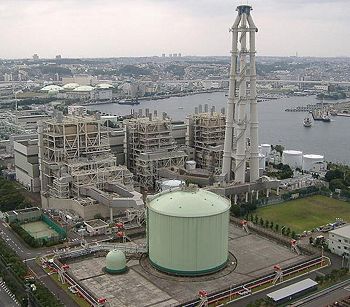User:Milton Beychok/Sandbox: Difference between revisions
imported>Milton Beychok No edit summary |
imported>Milton Beychok No edit summary |
||
| Line 1: | Line 1: | ||
{{Image|TEPCO Power Plant Japan.jpg|right|350px|Tokyo Electric Power Company (TEPCO), in Yokohama , Japan, fueled with liquified natural gas (LNG)}} | {{Image|TEPCO Power Plant Japan.jpg|right|350px|Power plant of the Tokyo Electric Power Company (TEPCO), in Yokohama , Japan, fueled with liquified natural gas (LNG)}} | ||
A '''steam generator''' is a device that uses a [[heat]] source to [[boiling point|boil]] liquid [[water]] and convert it into its [[Gas|vapor]] phase, referred to as [[steam]]. The heat may be derived from the [[combustion]] of a [[fuel]] such as [[coal]], petroleum fuel oil, [[natural gas]], [[municipal waste]] or [[biomass]], a [[nuclear fission]] reactor and other sources. | A '''steam generator''' is a device that uses a [[heat]] source to [[boiling point|boil]] liquid [[water]] and convert it into its [[Gas|vapor]] phase, referred to as [[steam]]. The heat may be derived from the [[combustion]] of a [[fuel]] such as [[coal]], petroleum fuel oil, [[natural gas]], [[municipal waste]] or [[biomass]], a [[nuclear fission]] reactor and other sources. | ||
There are a great many different types of steam generators ranging in size from small medical and domestic [[humidifier]]s to large steam generators used in [[conventional coal-fired power plant]]s that generate | There are a great many different types of steam generators ranging in size from small medical and domestic [[humidifier]]s to large steam generators used in [[conventional coal-fired power plant]]s that generate about 3,500 [[kilogram]]s of steam per [[Watt|megawatt]]-hour of [[energy]] production. The adjacent photo depicts an 1150 MW power plant with three steam generators which generate a total of about 4,025,000 [[Kilogram|kg]]/hour of steam. | ||
Many small commercial and industrial steam generators are referred to as ''"boilers"''. In common usage, domestic water heaters are also referred to as ''"boilers"''. However, domestic water heaters do not boil water nor do they generate any steam. | Many small commercial and industrial steam generators are referred to as ''"boilers"''. In common usage, domestic water heaters are also referred to as ''"boilers"''. However, domestic water heaters do not boil water nor do they generate any steam. | ||
Revision as of 19:18, 17 November 2009
A steam generator is a device that uses a heat source to boil liquid water and convert it into its vapor phase, referred to as steam. The heat may be derived from the combustion of a fuel such as coal, petroleum fuel oil, natural gas, municipal waste or biomass, a nuclear fission reactor and other sources.
There are a great many different types of steam generators ranging in size from small medical and domestic humidifiers to large steam generators used in conventional coal-fired power plants that generate about 3,500 kilograms of steam per megawatt-hour of energy production. The adjacent photo depicts an 1150 MW power plant with three steam generators which generate a total of about 4,025,000 kg/hour of steam.
Many small commercial and industrial steam generators are referred to as "boilers". In common usage, domestic water heaters are also referred to as "boilers". However, domestic water heaters do not boil water nor do they generate any steam.
